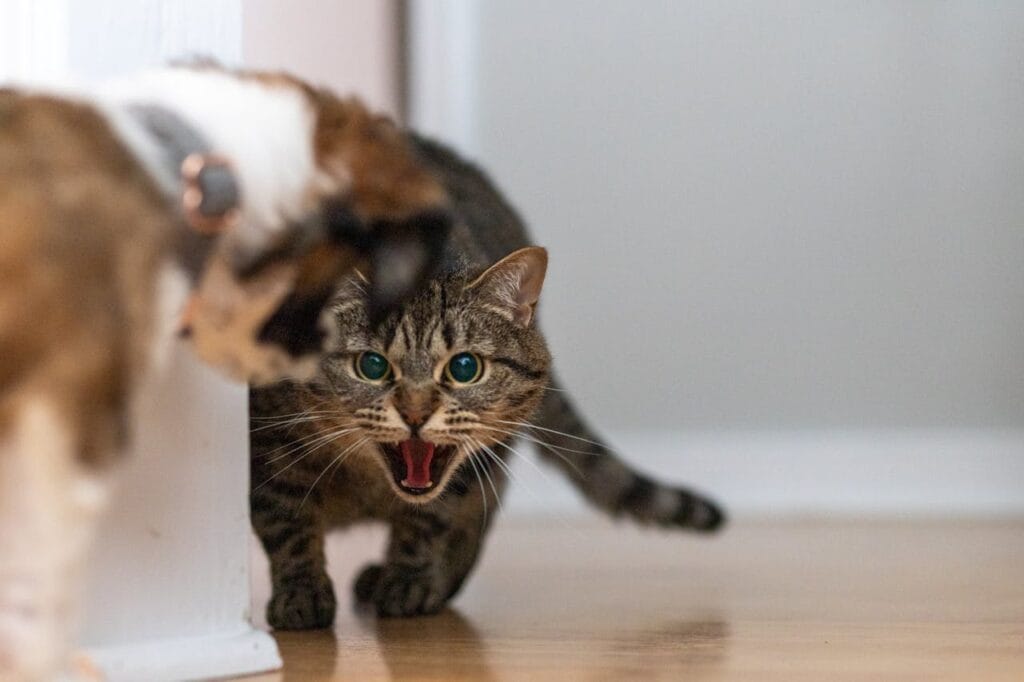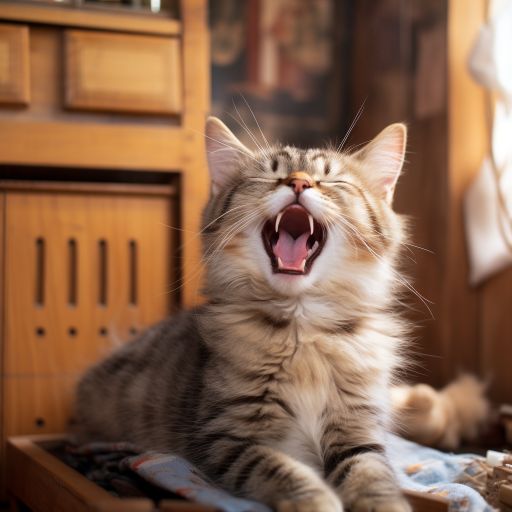Mastering Cat Aggression with 15 Secrets to a Peaceful Pet
Cats can be wonderful companions, filling our homes with joy, playfulness, and affection. However, not every cat is naturally sociable and friendly. Some cats may exhibit aggressive behaviors toward people, which can be both challenging and concerning for their owners. Understanding the reasons behind this aggression and knowing how to address it is crucial for creating a harmonious relationship with your feline friend. In this comprehensive guide, we will delve into the causes of cat aggression toward people, the signs to watch for, and effective strategies to prevent and manage this behavior.
Causes of Cat Aggression: Unveiling the Triggers
Understanding why a cat might become aggressive is the first step in addressing the issue. Here are the primary causes:
1. Fear: The Silent Trigger
Fear is a common trigger for aggression in cats. When a cat feels threatened or scared, it may lash out to defend itself. This fear can be caused by:
- Loud Noises: Sudden, loud noises can startle cats, making them feel unsafe.
- Sudden Movements: Quick, unexpected movements can trigger a defensive reaction.
- Unfamiliar People or Animals: New individuals or pets in the household can make a cat feel insecure and lead to cat aggression.
2. Pain: The Hidden Agitator
Cats in pain often exhibit aggressive behavior as a way of protecting themselves. This pain can stem from:
- Injuries: Any physical injury can cause discomfort and lead to aggression.
- Illnesses: Certain illnesses can make cats more irritable and prone to aggression.
- Underlying Medical Conditions: Chronic conditions, such as arthritis, can cause ongoing pain and contribute to aggressive behavior and lead to cat aggression.
3. Play Aggression: The Misdirected Energy
Cats, as natural hunters, may display aggressive behavior during playtime. Their predatory instincts can lead to biting or scratching, which although not intended to harm, can pose challenges for owners and result in cat aggression.
4. Territorial Aggression: The Protector Instinct
Cats are territorial animals and may become aggressive when they perceive a threat to their domain. This type of aggression can occur when:
- A New Pet is Introduced: Bringing a new pet into the home can disrupt a cat’s sense of security and lead to cat aggression.
- New People in the Household: New roommates or frequent visitors can make a cat feel that its territory is being invaded.
5. Maternal Aggression: The Protective Mother
Female cats that have recently given birth can exhibit maternal aggression. This behavior is a natural instinct to protect their kittens from perceived threats. Key factors include:
- Strangers Approaching Kittens: Unfamiliar people or animals coming near the kittens can trigger defensive behavior and lead to cat aggression.
- Handling Kittens: Excessive handling or disturbing the kittens can cause the mother cat to become aggressive.
6. Redirected Aggression: The Misplaced Anger
Redirected aggression occurs when a cat is agitated by something it cannot directly confront and then lashes out at a nearby person or animal. This type of aggression can be triggered by:
- Seeing Another Animal Outside: Observing another cat or animal outside a window can provoke frustration and cat aggression.
- Loud or Disturbing Events: Sudden loud noises or events that cause distress can result in the cat redirecting its aggression to a nearby target and lead to cat aggression.
7. Overstimulation: The Excessive Petting Reaction
Overstimulation aggression happens when a cat becomes overly excited or sensitive due to petting or handling. This can lead to sudden aggressive reactions. Key factors include:
- Prolonged Petting: Continuous petting beyond the cat’s comfort level can result in biting or scratching and lead to cat aggression.
- Sensitive Areas: Touching certain areas, like the belly or base of the tail, can trigger defensive behavior.
8. Lack of Socialization: The Missed Opportunities
Cats that are not properly socialized may exhibit aggressive behaviors. Early socialization is crucial for a cat’s development and can prevent aggression caused by unfamiliar situations. Key points include:
- Limited Exposure to People: Cats that have not been exposed to different people during their early months may become fearful and aggressive around strangers and lead to cat aggression.
- Isolation from Other Animals: Cats that are isolated from other animals may not learn how to interact appropriately, leading to aggression when they encounter other pets.
9. Anxiety or Stress: The Silent Burden
Cats experiencing anxiety or stress are more likely to display aggressive behavior. This can be caused by various factors, such as:
- Changes in Environment: Moving to a new home or significant changes in the household can cause stress and lead to cat aggression.
- Routine Disruptions: Alterations in daily routines, such as feeding times or play schedules, can make cats anxious and more prone to aggression.
10. Frustration: The Pent-Up Energy
Cats that are unable to satisfy their natural instincts and needs may become frustrated, leading to aggression. Key factors include:
- Lack of Stimulation: Cats that do not receive enough mental and physical stimulation may become bored and frustrated, resulting in aggressive behavior.
- Unfulfilled Hunting Instincts: Domestic cats still possess strong hunting instincts. Without proper outlets to express these instincts, such as interactive toys or play, they may become aggressive out of frustration which lead to cat aggression.
11. Changes in Routine: Disrupting the Familiar
Unexpected changes in a cat’s daily routine, such as alterations in feeding times or rearrangement of furniture, can trigger fear-based aggression. Cats thrive on predictability, and disruptions can make them feel insecure and defensive which lead to cat aggression.
12. Confinement or Restriction: The Claustrophobic Trigger
Being confined to a small space or restrained against their will can induce fear in cats. This sense of confinement can lead to aggressive behavior as the cat attempts to regain control of its environment or escape perceived threats wich lead to cat aggression.
13. Handling or Restraint: The Boundaries Crossed
Improper or uncomfortable handling, such as excessive restraint or rough petting, can evoke fear in cats. When they feel physically vulnerable or unable to escape, cats may resort to aggression as a defensive mechanism to protect themselves. This will lead to cat aggression.
14. Previous Trauma: Lingering Fear
Cats that have experienced trauma or abuse in the past may exhibit fear-based aggression as a result of lingering anxiety or mistrust which lead to cat aggression. Traumatic experiences can leave lasting emotional scars, causing cats to react defensively in similar situations.
15. Lack of Socialization: The Fear of the Unknown
Cats that have not been adequately socialized during their early development stages may exhibit fear-based aggression toward unfamiliar people, animals, or environments. Without exposure to different stimuli, cats may perceive new experiences as threats.

Recognizing the Signs of Cat Aggression: The Early Warnings
Being able to identify the signs of aggression in cats is essential for preventing potential incidents. Look out for the following behaviors:
1. Hissing or Growling: The Vocal Warnings
When a cat hisses or growls, it is signaling that it feels threatened or scared. These vocalizations are a clear indication that the cat is uncomfortable and may become aggressive if the perceived threat persists. This will lead to cat aggression.
2. Flattened Ears: The Defensive Posture
A cat that flattens its ears against its head is showing a defensive posture. This behavior indicates that the cat is preparing to protect itself and may attack if provoked and lead to cat aggression.
3. Dilated Pupils: The Anxious Eyes
Dilated pupils are a sign of anxiety or fear in cats. When a cat’s eyes are wide and its pupils are dilated, it is on high alert and may react aggressively to stimuli and lead to cat aggression.
4. Raised Fur Along the Back: The Physical Response
Raised fur along a cat’s back is a clear sign that it feels threatened. This reaction is part of the cat’s fight-or-flight response and can indicate that it is ready to defend itself.
5. Twitching Tail: The Agitated Indicator
A rapidly twitching or thumping tail is a sign that a cat is agitated or annoyed. This behavior can be a precursor to aggressive actions, such as swatting or biting which lead to cat aggression.
6. Stiff Body Posture: The Tense Stance
A cat that stands with a stiff, rigid body posture is showing signs of tension and readiness to react aggressively. This posture often accompanies other signs, such as flattened ears and dilated pupils.
7. Direct Stare: The Intense Gaze
An intense, unblinking stare directed at a person or animal can indicate that a cat is feeling threatened or challenged. This behavior often precedes an aggressive response and should be taken as a serious warning sign which lead to cat aggression.
8. Swatting or Paw Strikes: The Defensive Action
A cat that swats or strikes with its paws is showing a clear sign of aggression. This behavior can be a defensive reaction to perceived threats and indicates that the cat is ready to defend itself if necessary and lead to cat aggression.
9. Biting: The Aggressive Response
Biting is a definitive sign of aggression in cats. This behavior often follows other warning signs, such as hissing, growling, or swatting, and should be taken seriously as it can cause harm which lead to cat aggression.
10. Lunging or Pouncing: The Attack Mode
When a cat lunges or pounces at a person or animal, it is exhibiting an aggressive attack mode. This behavior can result from heightened fear, stress, or frustration and indicates a high level of aggression.
Preventing Cat Aggression: 15 Proven Techniques for a Harmonious Home
Preventing aggression in cats involves a combination of socialization, training, and understanding their needs. Here are seven effective strategies:
1. Socialization: Building Trust Early
Socializing your cat from a young age is crucial for preventing aggression. Expose your cat to different people, animals, and environments to help it become comfortable with new situations. This exposure will reduce fear-based aggression and build a more confident and sociable pet.
2. Positive Reinforcement: Rewarding Good Behavior
Use positive reinforcement techniques to train your cat. Rewarding good behavior with treats, praise, or affection can encourage your cat to repeat those behaviors. For example, if your cat uses a scratching post instead of furniture, reward it to reinforce this positive behavior.
3. Playtime: Channeling Energy Appropriately
Providing your cat with plenty of opportunities to play is essential for preventing boredom and aggression. Engage your cat with toys and interactive play sessions to help it release energy in a positive way. Regular playtime can reduce the likelihood of your cat resorting to aggressive behavior out of frustration or boredom.
4. Training: Redirecting Natural Instincts
Training your cat to use appropriate behaviors can help redirect its natural predatory instincts. Teach your cat to use a scratching post, play with designated toys, and engage in acceptable activities. Consistent training will help your cat understand what behaviors are expected and acceptable.
5. Creating a Safe Environment: Reducing Stress
A stress-free environment is crucial for preventing aggression in cats. Ensure your home is a safe and comfortable place for your cat by:
- Providing Hiding Spots: Give your cat places to retreat and feel secure.
- Maintaining a Routine: Cats thrive on routine, so try to keep feeding, playtime, and other activities consistent.
- Minimizing Stressors: Reduce exposure to loud noises, unfamiliar people, and other stressors.
6. Regular Health Check-ups: Addressing Medical Issues
Regular veterinary check-ups are essential for identifying and addressing any underlying medical issues that could cause pain and aggression. Keeping your cat healthy and pain-free will reduce the likelihood of aggression stemming from physical discomfort.
7. Professional Help: Seeking Expert Advice
If your cat’s aggression persists despite your best efforts, consider seeking help from a professional animal behaviorist or veterinarian. These experts can provide tailored advice and strategies to address your cat’s specific needs and challenges.
8. Environmental Enrichment: Stimulating the Senses
Providing an enriched environment can prevent aggression by keeping your cat mentally and physically stimulated. This can include:
- Interactive Toys: Use puzzle feeders and interactive toys to keep your cat engaged.
- Climbing Structures: Install cat trees and shelves to give your cat opportunities to climb and explore.
- Window Perches: Provide access to windows where your cat can watch birds and other outdoor activities.
9. Consistent Boundaries: Setting Clear Expectations
Establishing and maintaining consistent boundaries is important for preventing aggressive behavior. Ensure all family members understand and follow the same rules regarding your cat’s behavior, such as not allowing rough play or discouraging aggressive responses.
10. Desensitization: Gradual Exposure to Triggers
Desensitization involves gradually exposing your cat to things that trigger its aggression in a controlled and positive way. This method can help reduce fear and anxiety over time. For example, if your cat is afraid of visitors, start by having one calm guest sit quietly in the room and gradually increase the level of interaction as your cat becomes more comfortable.
11. Medication: Managing Severe Cases
In some cases, medication may be necessary to help manage a cat’s aggression, especially if it is related to anxiety or other psychological issues. Consult with a veterinarian to discuss the possibility of using medication as part of a comprehensive behavior modification plan.
12. Scent Therapy: Calming the Environment
Using pheromone diffusers or sprays can help create a calming environment for your cat. These products mimic the natural pheromones that cats produce to mark safe and secure areas, helping to reduce stress and aggression.
Implementing these twelve techniques can create a more harmonious and peaceful home environment for both you and your cat. By understanding your cat’s needs and addressing the underlying causes of aggression, you can foster a loving and positive relationship with your feline companion.
13. Safe Spaces: Providing Personal Areas
Create designated safe spaces for your cat where it can retreat and feel secure. These can be quiet, secluded areas of your home equipped with comfortable bedding, toys, and scratching posts. Safe spaces allow your cat to decompress and can help reduce stress-related aggression.
14. Gentle Handling: Respecting Boundaries
Always handle your cat gently and respect its personal space. Avoid forcing interactions, especially if your cat is showing signs of discomfort or stress. Allow your cat to approach you on its own terms and provide positive reinforcement when it seeks affection.
15. Observation and Adaptation: Tailoring Your Approach
Regularly observe your cat’s behavior and adapt your approach as needed. Every cat is unique, and what works for one may not work for another. Be patient and willing to adjust your strategies to better suit your cat’s individual needs and temperament.
Implementing these fifteen techniques can create a more harmonious and peaceful home environment for both you and your cat. By understanding your cat’s needs and addressing the underlying causes of aggression, you can foster a loving and positive relationship with your feline companion.

Conclusion: Nurturing a Gentle and Loving Cat
Understanding the reasons behind your cat’s aggression and implementing effective prevention strategies is key to fostering a harmonious relationship with your feline friend. By recognizing the signs of aggression, addressing the underlying causes, and employing positive reinforcement techniques, you can help your cat become a happier and more well-behaved pet.
Investing time and effort into socializing, training, and providing a stress-free environment will pay off in the form of a gentle and loving companion. Remember, a cat’s aggression is often a result of fear, pain, or confusion, and with patience and understanding, you can guide your cat toward more positive interactions.
Embrace these seven secrets to unlock the gentle side of your cat and enjoy a peaceful, fulfilling relationship with your beloved pet.
Live Pee Free! Odor Eliminator 100% Eliminates Pet Odor on Contact. 20% Off. No Enzymes, No Fragrance, No Detergent, No Bleach – Safe for Kids and Pets.



